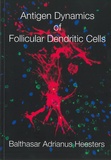Antigen dynamics of follicular dendritic cells

Heesters, Balthasar
- Promoter:
- Prof.dr. J.A.G. (Jos) van Strijp
- Co-promoter:
- Prof.dr. M.C. Carroll
- Research group:
- Strijp
- Date:
- January 14, 2015
- Time:
- 12:45 h
Summary
Stromal-derived follicular dendritic cells (FDCs) are a major depot for antigen that are essential for formation of germinal centers, the site where memory and effector B cells differentiate and high-affinity antibody production takes place. Historically, FDCs have been characterized as ‘accessory’ cells that passively support germinal center (GC) responses. However, our recent observations suggest that FDCs actively shape humoral immunity. In this dissertation, we discuss recent findings concerning the antigen acquisition and retention functions of FDCs, and relevant implications for protective immunity. We found that FDCs acquired complement-coated immune complexes (ICs) from noncognate B cells via complement receptors 1 and 2 (CD35 and CD21, respectively) and rapidly internalized them by an actin-dependent pathway. ICs were retained intact within a nondegradative cycling compartment and were displayed periodically on the cell surface where they were accessible to antigen-specific B cells. Furthermore, we discuss how FDCs are involved in persistence of Human Immunodeficiency Virus (HIV) in people on antiretroviral therapy (ART). Treatment with ART substantially reduces viral load and limits disease progression in subjects with HIV infection. Despite the success of ART, it does not cure HIV and discontinuation of treatment results in viral rebound. Growing evidence implicates lymph nodes (LN) as a major site for continued infection of CD4 T cells, but the cell sources of a persistent reservoir within LN remain unclear. We found that human FDC isolated from subjects on ART retain infectious HIV via binding to complement receptor 2 (CD21) within a cycling compartment and transmit infectious virus to CD4 T cells in vitro. Importantly, treatment of the HIV+ FDC with a soluble complement receptor 2 (sCD21-Ig) purges the FDC of HIV virions and prevents transmission of infectious virus in vitro. These results provide evidence that reservoirs are not restricted to infected cells and provide a method to purge one reservoir not targeted by conventional therapy. Our results suggest that sCD21-Ig could be a potential component of new therapeutic strategies to achieve functional cure or viral eradication in ART-treated HIV-infected humans. Finally, we show S. pneumonia binds only in the medulla of the LN and that a subset of dendritic cells (DC), besides B cells) are required for the transport of S. pneumoniae to FDC, independent of macrophages. A robust humoral immune response and germinal center formation requires transport of antigen to the FDC. A better understanding of this process can contribute to improvement of future vaccine design.